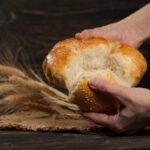There is nothing better than filling your home with the scent of a homemade pie baking in the oven.
However, it can be disheartening when you find that your pie crust shrinks and changes the appearance of your pie.
Thankfully, there are plenty of tried and tested ways to avoid this problem occurring.
Why Does Your Pie Crust Shrink?
Before we look at how to stop your pie crust from shrinking, it is important to understand why your pie crust might be shrinking in the first place.
There are a few common reasons why a pie shell might shrink.
One of the most common reasons is that the pie dough hasn’t been allowed to rest properly.
When this happens, the pie dough isn’t as malleable as it could be which causes the pie crust to shrink.
Another reason pie crusts shrink is that they have been left at room temperature for too long pre-baking.
Ideally, pie crusts should be kept almost ice cold until you place them in the oven to bake.
This also means that if the oven temperature isn’t correct when you put the pie crust in the oven, it can cause a shrinking crust.
A final reason why your pie crust might shrink is that you have overworked the pie dough.
How To Keep Your Pie Crust From Shrinking
Now that we have covered some of the main causes for a homemade pie crust to shrink, we can look at some ways in which we can prevent a pie crust from shrinking.
These tips should help you make perfect pie crusts and have you baking pies more regularly.
Allow The Dough Time To Rest
One of the most common reasons for a pie crust to shrink is that the dough hasn’t been allowed enough resting time.
When you allow pie dough to rest, you allow the gluten content to relax which helps prevent the shrinking of the pie crust.
There are certain times during the process of making pie crust when you should allow the pie dough to rest.
Without periods of rest, you run the risk of overworking your dough which is another cause of shrinking your pie crusts.
There are three key moments when you should allow your dough rest.
These are during and after mixing your dough, after rolling your dough, and once you have placed the dough into the pie pan.
When mixing your dough, make sure to not work too slowly as your ingredients will begin to warm up which changes the consistency of the dough. If you find that this is happening, you should let your dough rest in the refrigerator or freezer for 10 to 15 minutes until it is chilled again.
If you find you are having to do this often, you can keep a bowl of ice water next to you to dip your hands in to keep them cool throughout the process.
The total rest period for your pie dough should be at least an hour with all the steps completed properly and the dough kept cold.
Keep Your Pie Dough Cold
As we mentioned above, keeping your pie crust cold throughout the process until it reaches the oven is super important in preventing the pie crust from shrinking.
All of the ingredients that you use to make your pie dough should be ice cold throughout the process pre-baking.
This applies to your butter, milk, or water. To make sure that your milk or water stays ice cold while you are preparing your ingredients or pie pan, you can add some ice cubes to the liquid.
Keeping the ingredients cold helps to keep the fat solid and prevent shrinking.
Don’t Overwork Your Dough
Overworking your dough is another common reason for a pie crust to shrink.
This can particularly be an issue if you are using a food processor instead of your hands.
When you overwork your pie crust, it will become tough and hard which increases the chance of it shrinking.
You only need to mix the ingredients for your pie crust until the components are combined, similar to making cake batter.
Even better, with a pie crust, you can leave some lumps of fat visible, and the crust will be fine.
Be Gentle When Placing It Into Your Pan
One of the most common reasons for a pie to shrink away from the edges of a pie dish is because it has been forced into the pan.
Making pie crusts requires finesse throughout, including placing it into the dish.
You should avoid stretching your dough as much as possible.
To do this, make sure that you have rolled out the pie dough so that it is big enough to cover the whole pie plate.
If you have excess pie crust, that’s great as it can be trimmed.
Preheat Your Oven
Maintaining the correct temperature throughout the process of making pies.
This applies to the temperature of the oven.
Preheating your oven to the correct temperature helps to prevent your crust from shrinking away from the pie pan as the fat melts too early.
Using an oven thermometer can help ensure that your oven is neither too hot nor too cold.
Don’t Add Too Much Water
Excess water in your pie crust can be a major cause of shrinking.
This is because the water evaporates as the pie crust bakes.
If you do need to add extra water to help your ingredients combine, some great tips include, only adding a teaspoon at a time and using high-quality ingredients to prevent the need.
Set Your Pie Crust Using Two Pans
You can also help prevent your pie crust from shrinking by setting it with another pie plate before you bake it.
For this, you need two pie plates that are the same size.
Line one with the pie crust as normal.
Then, while you are letting your dough rest, spray the bottom of the other pie plate with non-stick spray and gently place it on top of your dough to set it while it is in the freezer.
Don’t use A Glass Baking Dish
This is a simple one. Avoid using glass pie plates.
This is because glass doesn’t conduct heat well and your crust won’t bake as it should in a pie dish like this.
Better materials for a good pie plate include ceramic and metal.
Glass pie pans also have a slippery surface that can cause your crust to shift during baking.
Does Blind Baking Help?
Blind baking can be helpful in preventing shrinkage and soggy bottoms.
The best thing about blind baking is that anything can be used as pie weights if you don’t have any.
When blind baking, you can use dried beans or uncooked rice on parchment paper to prevent proofing.
Final Thoughts
Whether you are making a pumpkin pie, apple pie, or other fruit pies, these are such great tips that you can use to make sure your pie crust is perfect.










